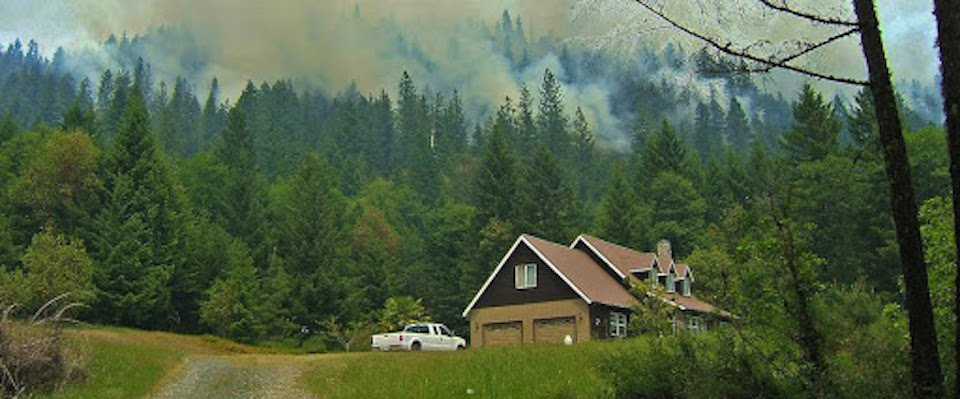Edna Colridge was irritated when her dog jumped on her chest, rousing her from a deep sleep. Then she looked out the window and noticed that the sky was red. A few seconds later, she saw that her neighbor’s house was engulfed by flames. And the house behind that. The entire neighborhood, she realized, was burning.
“We gathered our pets and took some documents from the safe,” says Colridge. “I was outside on the street when a policeman drove by, and he was livid, yelling for me to get out of there. I said I was waiting for my husband, and he screamed, ‘Leave him! You don’t have the time!’ Well, I didn’t leave him, of course, but by the time we drove away everything was one big fireball. We almost didn’t make it.”
The couple escaped from Coffey Park, the Santa Rosa neighborhood that was virtually wiped out by the 2017 Tubbs Fire. About 1,500 homes burned in Coffey Park on the night of October 8, the Colridge’s house among them. The blaze was almost apocalyptic in scope, but it also was anomalous—or at least it seemed so at the time. Coffey Park is a typical suburban neighborhood surrounded by residential developments and commercial complexes. It isn’t located near any forests or brushlands, so you wouldn’t expect it to burn down in a wildfire. But the Tubbs Fire was driven by gale-force winds, burning downslope from the Mayacamas Mountains. It jumped Highway 101, sending embers into the landscaped environs of Coffey Park. Dried leaves in gutters and under eaves ignited. The winds roared, and the neighborhood burned to the ground.
“The understanding we have is that we’re seeing increases in insurance rates in both the WUI and in areas that weren’t previously considered the WUI [but may be now],” says Lamm. “It’s not a crisis yet, but it could certainly become one.”
“I mean, it blew across six lanes of freeway traffic,” said Colridge, shaking her head. “We never thought we were in danger from wildfires. No one did. Why would you think that? Nothing like this had ever happened before.”

In the aftermath of the fire, Coffey Park was a vast expanse of blackened concrete and twisted steel, with a few defoliated, skeletal trees poking up from the rubble. Today, less than two years after the Colridges fled, they are back, recently moved into their new home. Houses in various stages of construction surround them, and the clamor of nail guns and power saws can be heard through the neighborhoods. Coffey Park has been resurrected from the ashes.
But the Tubbs Fire destroyed any illusions that city suburbs are safe from wildfire. Though Coffey Park is far from flammable woodlands, the fact it burned once means it can burn again, and insurance companies are adjusting the prices of their policies accordingly. The cost of such insurance—and its availability—bode big changes for where and how Californians will live in an era of accelerating climate change. Thousands of homes once considered invulnerable to fire are now defined by their “wildfire risk.” And the economic impacts of this shift are only beginning to be felt.
“You worry about it,” says Colridge. “We’re frugal people and we watch our money, but you worry you might not be able to afford the premiums. And you worry even more about whether you’ll be dropped or not, whether you’ll even be given the option for a policy.”
Indeed, companies already are redlining some homes in California’s so-called Wildland Urban Interface (WUI), areas where, unlike Coffey Park, woodlands and chaparral butt up against residential developments.
“It happened to my own parents,” said Micele Auch, who co-owns a company that is landscaping new homes in Coffey Park. “My parents own a cabin at Lake Pillsbury [in Lake County], and their insurance company dropped them after a big fire went through the area.”
The acreage burned in California wildfires has increased by 500 percent since 1972, a trend likely fueled by “anthropogenic warming,” or human-induced climate change, according to a new study published in Earth’s Future. As last year’s Paradise Fire strongly suggests, entire communities in the WUI are now at risk of total annihilation from bigger, more intense fires.
These trends constitute a “shifting landscape of insurance affordability” in California, says Ted Lamm, a research fellow in the Climate Program at Berkeley Law’s Center for Law, Energy & the Environment.
“The understanding we have is that we’re seeing increases in insurance rates in both the WUI and in areas that weren’t previously considered the WUI [but may be now],” says Lamm. “It’s not a crisis yet, but it could certainly become one.”
In theory, rising premiums should send a price signal to counties, builders, and residents that development should migrate to less fire-prone areas, Lamm says.
But that isn’t happening—not in Santa Rosa, at least. The insurance industry now considers Coffey Park more vulnerable to fire than it was two years ago, and while premiums are rising, redevelopment is forging ahead. Homes are going up all over Fountaingrove, an exclusive ridgetop development in Santa Rosa that also burned down during the Tubbs Fire. Reconstruction has raised more than a few eyebrows. The Tubbs Fire matched the footprint of an earlier major blaze, the 1964 Hanley Fire, to a remarkable degree, and given its history, Fountaingrove will almost certainly burn again.
In contrast to Coffey Park, Fountaingrove’s residents are by and large wealthy; most will either pay higher insurance premiums or simply assume the risk if their carriers drop them. The bigger problem, observes Lamm, is that “insurance comes into play only after a decision has been made to build.” So there remains no overriding disincentive to build in the WUI. The developer isn’t required to take insurance into account, and individuals building dream houses often don’t factor in insurance premiums—or no insurance—until they are fully committed to construction.
But even if people living in places like Coffey Park and Fountaingrove (not to mention Malibu, Mill Valley, the East Bay Hills, among others) are willing to move into houses with the specter of high premiums hovering overhead, fire insurance may ultimately prove their undoing. Homeowners may find they’re unable to pay premiums at some point or that their carriers have dropped them, putting perhaps their biggest assets at risk.
From 2015 to 2016 alone, there was a 15.3 percent increase in insurance non-renewals in fire-prone areas, according to a 2017 California State Insurance Commission report.
“Those are the most current figures available, but we can assume that trend has continued,” said David Jones, California’s former insurance commissioner and the newly-appointed director of the climate risk initiative at Berkeley’s Center for Law, Energy and the Environment.
“There are between 3.5 million to 4.3 million homes in the WUI [in California],” says Jones. “Of those, about one million are in high to very high fire risk zones.” And homeowners in high risk areas are facing, on average, a fifty percent premium rate increase.
So in the worst-case scenario—when their insurance policies are cancelled—what do residents of the WUI do?
Some go on a FAIR (Fair Access to Insurance Requirements) Plan, says Jones. Established by Congress in 1968, such plans allow “last resort” insurance coverage to people living in areas at high risk for natural disasters. But policies written for California’s WUI only cover direct fire losses—and they’re expensive. For many low-income households, they’re a nonstarter: their coverage is inadequate and the premiums remain too high.

None of that will likely stop development in fire-prone areas; the WUI is simply too attractive, too irresistibly bucolic, for some people to forego building. What’s more, with urban real estate values skyrocketing, many California cities are becoming too expensive for lower and even middle-class families. (That’s increasingly the case for Santa Rosa, where numerous Coffey Park residents took their insurance money, sold their burned-out empty lots, and moved to other, cheaper locales.) Putting up a doublewide trailer in a small community deep in the forested hinterlands can be a pragmatic alternative to such housing pressures—fire insurance be damned.
Planners may not be powerless, however. Shortly before leaving the insurance commission, Jones helped draft several proposals to control growth in the WUI, moderate wildfire risk, and expand fire insurance availability.
“A key recommendation was that the state legislature should enact a fee on new development projects in the WUI, with proceeds going for wildfire prevention and improved forest management programs,” says Jones, “the idea being that these developments ought to pay their own way for future wildfire losses.”
Jones also recommended establishing home and community “resiliency” standards, such as expanding fuel-free zones around houses and using fire-resistant materials and designs in new home construction.
“The state would then require insurance companies to offer standard policies to homes that meet those standards,” says Jones. “Currently, insurance companies are using fairly unsophisticated risk models to decide whether or not they want to renew policies. When I was with the commission, we determined that these models don’t take into account such risk-reduction measures as protected eaves, fire-resistant hardened glass and roofing materials, the absence of attached structures, and adequate, cleared defensible space. Instead, they only look at things like topography, wind direction, and the general risk in a given area. This is a big problem. We need to take into account the things home owners are doing individually to reduce risk.”
Finally, says Jones, FAIR plans should be recalibrated to help low-income households. FAIR is sometimes perceived as a taxpayer subsidized scheme, he says, but this is wrong. Though authorized by the federal government and supervised by the state, FAIR insurance is handled by private carriers. Because the risk is extreme, the premiums are high and the coverage minimal. In other words, the FAIR plan is regressive: only relatively wealthy people can afford it. While the larger issue may be continued development in the WUI, it’s also true that FAIR won’t be truly fair until it accommodates the poor as well as the rich. That means targeted government support.
“The idea isn’t to suppress the premium price, because the premiums reflect the actual risk,” says Jones. “It’d essentially function like Covered California does for health care—it would simply allow low-income people to participate.”
Of course, not all the costs of building—or rebuilding—after a wildfire are financial. Edna Colridge, for one, still has trouble sleeping, and she finds herself tearing up at unexpected moments. She worries about costs, but she also just worries—generally. The Tubbs Fire took her peace of mind along with her heirloom jewelry and family keepsakes.
“When the wind comes up, it brings back everything that happened that night,” she says, a slight tremor in her voice. “I don’t know if that will ever change.”





















